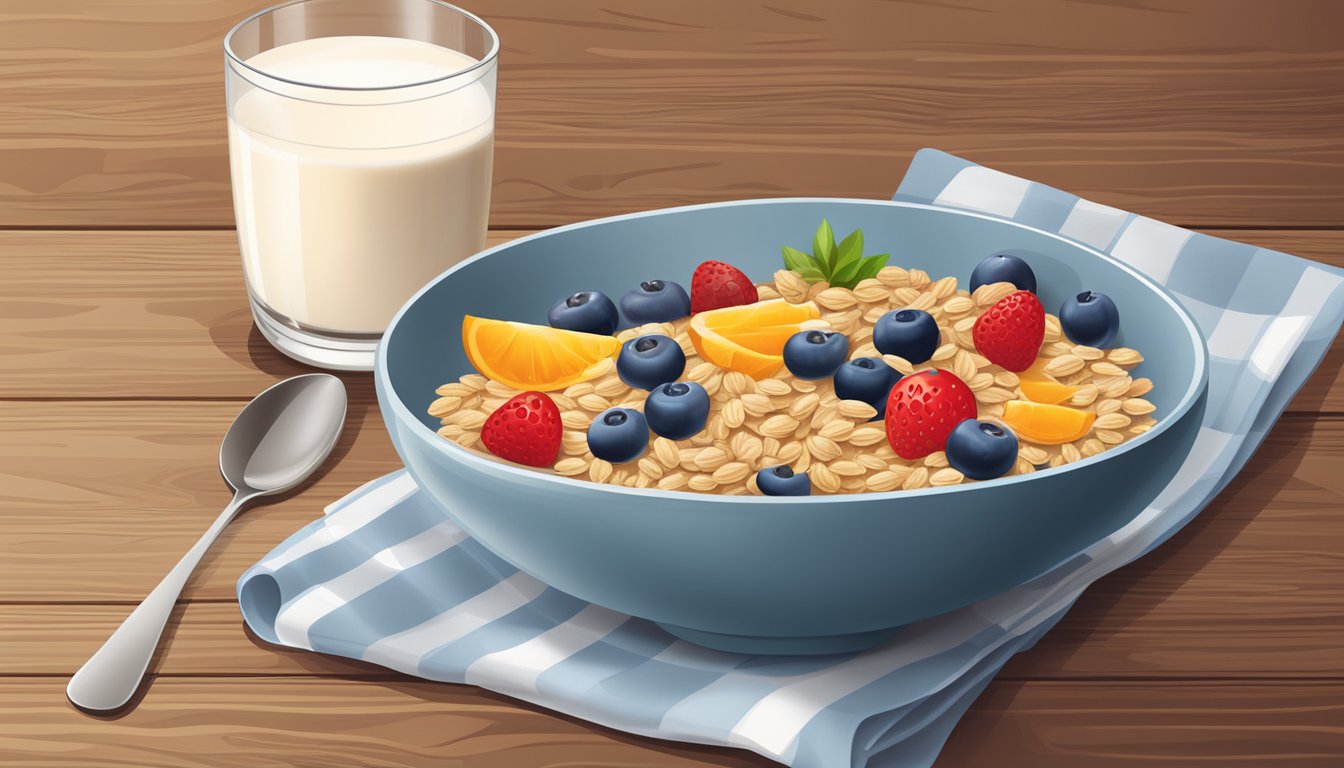Breakfast cereal is a quick and convenient option for many people starting their day. With countless varieties lining grocery store shelves, choosing a healthy cereal can be challenging. While taste preferences vary, nutrition experts generally agree on key factors that make a cereal healthy.
The healthiest breakfast cereals tend to be high in fiber, low in added sugars, and made with whole grains. Options like plain shredded wheat, bran flakes, and oat-based cereals often top dietitians’ lists. These cereals provide important nutrients and can help keep you feeling full throughout the morning.
When selecting a healthy cereal, it’s important to check the nutrition label. Look for cereals with at least 3 grams of fiber per serving and minimal added sugars. Ingredients like whole wheat, oats, or bran should be listed first. Avoiding cereals with artificial colors, flavors, and excessive preservatives is also advisable for those seeking the most nutritious options.
The Importance of Breakfast
Breakfast provides essential nutrients and energy to start the day. It supports cognitive function, metabolism, and overall health when chosen wisely.
Nutritional Significance
Breakfast offers a prime opportunity to consume key nutrients. Whole grain cereals can provide fiber, vitamins, and minerals crucial for optimal bodily functions. Fiber aids digestion and promotes satiety, helping regulate appetite throughout the day.
Many cereals are fortified with essential vitamins and minerals like iron, B vitamins, and vitamin D. These nutrients support energy production, immune function, and bone health. Protein-rich options can help build and repair tissues.
Some cereals contain antioxidants from whole grains or added fruits, which may protect cells from damage. Cereals with nuts or seeds can provide healthy fats, including omega-3 fatty acids, beneficial for heart and brain health.
Impact on Health and Wellness
A nutritious breakfast can positively influence various aspects of health. It jumpstarts metabolism, potentially aiding in weight management. Consuming fiber and protein in the morning helps stabilize blood sugar levels, supporting sustained energy.
Regular breakfast eaters often have better concentration and memory throughout the day. This can lead to improved work or school performance. Eating breakfast is associated with a lower risk of certain chronic diseases, including heart disease and type 2 diabetes.
For children and adolescents, a healthy breakfast is linked to better academic performance and reduced absenteeism. It also supports proper growth and development during crucial years.
Understanding Cereal Components
Breakfast cereals contain various ingredients that impact their nutritional value. The type of grains, sugar content, and other additives play crucial roles in determining a cereal’s healthiness.
Whole Grains vs. Refined Grains
Whole grains retain all parts of the grain kernel, including the bran, germ, and endosperm. They provide more fiber, vitamins, and minerals than refined grains. Cereals made with whole grains like oats, brown rice, and quinoa offer superior nutritional benefits.
Refined grains, on the other hand, have been processed to remove the bran and germ layers. This process strips away many nutrients, leaving mostly carbohydrates. Cereals made with refined grains are often enriched with vitamins and minerals, but they lack the natural fiber and other beneficial compounds found in whole grains.
Added Sugars and Their Effects
Many breakfast cereals contain added sugars to enhance flavor. These sugars contribute extra calories without providing essential nutrients. Excessive sugar consumption can lead to weight gain, tooth decay, and increased risk of chronic diseases.
The American Heart Association recommends limiting daily added sugar intake to 24 grams for women and 36 grams for men. Some cereals can contain a significant portion of this recommended limit in a single serving.
To identify added sugars, look for terms like sucrose, high fructose corn syrup, and dextrose on the ingredient list.
Nutrition Label Basics
Understanding nutrition labels is key to making informed cereal choices. The serving size is listed at the top of the label and can vary between cereals. Pay attention to this information, as all nutritional values are based on this serving size.
Key components to check include:
- Total calories per serving
- Fiber content (aim for at least 3 grams per serving)
- Added sugars (lower is better)
- Protein content
- Vitamins and minerals
Compare these values between different cereals to make the healthiest choice. Remember that a balanced diet includes a variety of nutrient sources, not just breakfast cereal.
Key Nutrients in Healthy Cereals
Nutritious breakfast cereals contain essential components that fuel the body and support overall health. These key nutrients provide energy, promote digestive health, and help meet daily nutritional requirements.
Fiber and Its Benefits
Fiber is a crucial element in healthy cereals. It aids digestion, promotes feelings of fullness, and helps maintain stable blood sugar levels. Aim for cereals with at least 5 grams of fiber per serving. Whole grain cereals are excellent sources of both soluble and insoluble fiber.
Soluble fiber can help lower cholesterol levels, while insoluble fiber supports regular bowel movements. Some high-fiber cereals include bran flakes, shredded wheat, and oat-based options.
To boost fiber intake, consider adding fresh fruits like berries or sliced banana to your cereal bowl.
Protein-Enriched Options
Protein-rich cereals provide sustained energy and help build and repair tissues. Many cereals now offer enhanced protein content through added ingredients like nuts, seeds, or protein isolates.
Look for options with at least 5 grams of protein per serving. Greek yogurt-based cereals, granolas with almonds or pumpkin seeds, and quinoa-based cereals are good protein sources.
Combining cereal with milk or a plant-based alternative can further increase the protein content of your breakfast.
Vitamins and Minerals for Daily Needs
Healthy cereals are often fortified with essential vitamins and minerals. These micronutrients support various bodily functions and help meet daily nutritional requirements.
Common fortifications include:
- B vitamins (thiamin, riboflavin, niacin, folate)
- Iron
- Vitamin D
- Calcium
- Zinc
Whole grain cereals naturally contain more vitamins and minerals than refined grain options. Check the nutrition label for percentages of daily values to ensure you’re getting a good variety of micronutrients.
Some cereals also include antioxidants like vitamin E, which can support immune function and overall health.
Varieties of Healthy Cereals
Healthy cereals come in diverse options to suit different dietary preferences and nutritional needs. From classic whole grains to innovative grain-free alternatives, the market offers a wide range of choices for health-conscious consumers.
Classic Whole Grain Cereals
Whole grain cereals form the foundation of nutritious breakfast options. Oatmeal, a popular choice, provides fiber, protein, and essential minerals. It can be prepared in various ways, from instant to steel-cut varieties. Muesli, a blend of rolled oats, nuts, and dried fruits, offers a balance of nutrients and natural sweetness. Many brands now fortify their whole grain cereals with additional vitamins and minerals.
Bran flakes and wheat biscuits are other wholesome options. These cereals often contain high amounts of fiber, which aids digestion and promotes heart health. Some varieties include added seeds like flax or chia for extra nutritional benefits.
Innovative Grain-Free and Low-Carb Alternatives
For those following specific diets, grain-free and low-carb cereals have emerged as popular alternatives. These often use ingredients like nuts, seeds, and coconut to mimic traditional cereal textures. Keto-friendly options may include almond flour or coconut flakes as base ingredients.
Some brands create cereals from legumes or root vegetables, offering unique flavors and textures. These alternatives can be rich in protein and fiber while keeping carbohydrate content low. Many grain-free cereals are also naturally gluten-free, catering to those with gluten sensitivities or celiac disease.
Specialty Cereals for Dietary Needs
Specialty cereals cater to specific dietary requirements and health goals. Gluten-free cereals, made from rice, corn, or quinoa, provide safe options for those with gluten intolerance. High-protein cereals, often fortified with additional protein sources, support muscle health and satiety.
Low-sugar cereals address concerns about excessive sugar intake. These may use natural sweeteners or rely on the inherent sweetness of ingredients like dried fruit. Some specialty cereals focus on gut health, incorporating prebiotics or probiotics into their formulations.
Organic and non-GMO cereals appeal to consumers seeking minimally processed options. These cereals often emphasize sustainably sourced ingredients and environmentally friendly packaging.
Health Benefits of Popular Cereal Ingredients
Breakfast cereals often contain nutrient-dense ingredients that provide essential vitamins, minerals, and fiber. These components can contribute to overall health and wellbeing when consumed as part of a balanced diet.
Super Grains and Their Nutritional Profiles
Quinoa stands out as a complete protein source, containing all nine essential amino acids. It’s rich in fiber, iron, and magnesium. Buckwheat, despite its name, is not related to wheat and is gluten-free. It’s high in antioxidants and provides a good source of manganese and copper.
Millet is another gluten-free grain that’s packed with B vitamins and minerals like iron and zinc. Barley contains beta-glucans, a type of soluble fiber that may help lower cholesterol levels. It’s also a good source of selenium and manganese.
These super grains can boost the nutritional value of cereals significantly:
- Quinoa: 8g protein per cup (cooked)
- Buckwheat: 6g fiber per cup (cooked)
- Millet: 6g protein per cup (cooked)
- Barley: 6g fiber per cup (cooked)
Nuts, Seeds, and Dried Fruits as Add-Ons
Nuts like almonds and walnuts provide healthy fats, protein, and vitamin E. They can help reduce inflammation and support heart health. Chia seeds are rich in omega-3 fatty acids and offer a good source of calcium and phosphorus.
Dried fruits add natural sweetness and concentrated nutrients. Raisins, for example, contain iron and potassium. However, they’re also high in sugar, so moderation is key.
Nutrient-dense add-ons per 1 oz serving:
- Almonds: 6g protein, 14g healthy fats
- Chia seeds: 4g protein, 11g fiber
- Raisins: 1g fiber, 7% daily value of iron
These ingredients can enhance the flavor and nutritional profile of cereals, making them more satisfying and beneficial.
Fortified Cereals and Their Added Nutrients
Many cereals are fortified with additional vitamins and minerals to boost their nutritional value. Common additions include:
- B vitamins (B1, B2, B3, B6, B12): Support energy metabolism
- Vitamin D: Aids calcium absorption for bone health
- Iron: Essential for oxygen transport in the blood
- Zinc: Supports immune function and wound healing
- Folic acid: Important for cell growth and development
A typical serving of fortified cereal can provide 25-100% of the daily recommended intake for these nutrients. This can be particularly beneficial for individuals with specific dietary needs or restrictions.
Fortification helps address nutrient deficiencies in the population. For example, folic acid fortification has been linked to a reduction in neural tube defects in newborns.
Optimizing Your Cereal Bowl
Creating a nutritious cereal bowl involves more than just pouring cereal into a dish. Proper portion control, milk selection, and thoughtful additions can transform your breakfast into a balanced, satisfying meal.
Best Practices for Portion Control
Measuring cereal servings accurately helps maintain a healthy diet. Use a measuring cup to portion out the recommended serving size, typically 3/4 to 1 1/2 cups for most cereals. This practice prevents overeating and ensures you’re getting the intended nutritional benefits.
Avoid using oversized bowls, which can lead to larger portions. Instead, opt for smaller bowls that make standard servings appear more substantial.
Consider using a food scale for precise measurements, especially when trying new cereals with different densities. This method guarantees consistent portion sizes across various brands and types.
Choosing the Right Milk and Alternatives
Selecting an appropriate milk or alternative can significantly impact your cereal’s nutritional profile. Low-fat milk provides essential nutrients without excess calories. It offers calcium, vitamin D, and protein while keeping fat content in check.
Plant-based alternatives like almond, soy, or oat milk can be excellent choices for those with dietary restrictions or preferences. Look for fortified versions to ensure you’re getting similar nutrients to dairy milk.
Unsweetened varieties help control added sugar intake. If using flavored options, be mindful of their sugar content and adjust your cereal portion accordingly.
Healthy Additions to Enhance Your Meal
Boost your cereal’s nutritional value with thoughtful toppings. Fresh fruits like berries, sliced bananas, or diced apples add natural sweetness, fiber, and vitamins. They provide a refreshing contrast to the cereal’s texture.
Dried fruits offer concentrated flavor and nutrients. Raisins, cranberries, or goji berries can add a chewy texture and antioxidants. Use them sparingly due to their higher calorie density.
Nuts and seeds introduce healthy fats, protein, and crunch. Almonds, walnuts, or chia seeds can make your cereal more satiating. Sprinkle a small handful for added nutrition without excessive calories.
Greek yogurt can replace milk for a protein-rich, creamy alternative. It pairs well with granola-style cereals and adds probiotics for gut health.
Cereal-Related Health Considerations
Breakfast cereals can have significant impacts on health, both positive and negative. Key factors to consider include sugar and sodium levels, effects on weight management, and potential for disease prevention.
Sugar and Sodium Content Concerns
Many breakfast cereals contain high amounts of added sugars and sodium. Excessive sugar intake is linked to obesity, tooth decay, and increased risk of type 2 diabetes. Some cereals pack up to 12 grams of sugar per serving.
Sodium content in cereals can also be problematic. High sodium intake is associated with elevated blood pressure. Some cereals contain over 200 mg of sodium per serving.
To make healthier choices:
- Choose cereals with less than 6 grams of sugar per serving
- Opt for low-sodium varieties (less than 140 mg per serving)
- Read nutrition labels carefully
The Role of Breakfast Cereal in Weight Management
Cereal can be part of a balanced diet for weight management when chosen wisely. High-fiber cereals promote feelings of fullness, potentially reducing overall calorie intake.
Whole grain cereals are particularly beneficial:
- Provide complex carbohydrates for sustained energy
- Offer essential nutrients like B vitamins and iron
- Contain fiber that aids digestion and promotes satiety
Portion control is crucial. Stick to recommended serving sizes to avoid excess calorie consumption. Pairing cereal with low-fat milk and fresh fruit can create a nutritious, balanced breakfast.
Cereals and the Prevention of Lifestyle Diseases
Certain types of breakfast cereals may help reduce the risk of chronic diseases. Whole grain cereals are associated with lower rates of heart disease, type 2 diabetes, and certain cancers.
Key benefits:
- Fiber in whole grains helps lower cholesterol levels
- Antioxidants in cereals combat inflammation
- B vitamins support heart health and metabolism
Fortified cereals can address nutrient deficiencies. Many are enriched with folate, which is crucial for pregnant women to prevent birth defects. Iron-fortified cereals help reduce the risk of anemia.
For optimal health benefits, choose cereals that are high in fiber, low in added sugars, and fortified with essential nutrients.
Comparative Analysis of Cereal Brands
Breakfast cereals vary widely in their nutritional profiles and ingredients. A closer look reveals key differences between popular brands and their impact on health.
Top Choices for a Healthy Breakfast
Grape Nuts stands out as a nutrient-dense option with a simple ingredient list. It provides high fiber content and essential vitamins without added sugars.
Nature’s Path Organic Heritage Flakes Cereal offers a wholesome choice. Made with organic whole grains, it delivers a good balance of fiber and protein.
Cheerios, a longtime favorite, contains whole grain oats and boasts low sugar content. Its simple formula makes it a heart-healthy pick for many consumers.
Alpen Muesli presents a mix of whole grains, nuts, and dried fruits. This combination provides a variety of nutrients and a satisfying texture.
Market Trends and Consumer Favorites
Honey Nut Cheerios remains a top seller despite higher sugar content than original Cheerios. Its sweet taste appeals to many, though it’s less optimal for health-conscious consumers.
Organic cereals like those from Nature’s Path have gained popularity. Consumers increasingly seek out brands that prioritize organic ingredients and minimal processing.
Many cereal brands now offer reduced-sugar versions of popular products. This trend responds to growing awareness of sugar’s health impacts.
Granola-style cereals have seen a surge in demand. Consumers appreciate their versatility as both a breakfast food and a snack option.
Evaluating Claims: Marketing vs. Nutrition
Cereal packaging often features health claims that require scrutiny. “Made with whole grains” doesn’t guarantee a product is high in fiber or low in added sugars.
Some brands use terms like “natural” or “no artificial flavors” to imply healthiness. These claims don’t necessarily indicate superior nutritional value.
Fortification with vitamins and minerals is common in cereals. While beneficial, it doesn’t compensate for poor overall nutritional profiles.
Serving sizes listed on nutrition labels often underestimate typical portions. Consumers should pay attention to these measurements for accurate comparisons.
Sugar content varies significantly between brands and flavors. Even cereals marketed as healthy may contain high amounts of added sugars.
Sustainable and Ethical Considerations

Choosing a healthy breakfast cereal involves more than just nutrition. Environmental impact and production methods also play crucial roles in determining the overall quality of cereal options.
Organic and Non-GMO Options
Organic cereals offer several benefits for health-conscious consumers. These products are made without synthetic pesticides or fertilizers, reducing chemical exposure. Nature’s Path Organic leads the way with a wide range of certified organic cereals.
Non-GMO cereals avoid genetically modified ingredients, appealing to those concerned about potential long-term effects. Many organic cereals are also non-GMO by default. Whole-grain and sprouted grain cereals often fall into this category, providing added nutritional benefits.
When selecting cereals, look for trusted certifications like USDA Organic or Non-GMO Project Verified on packaging.
Environmental Impact and Production Practices
Cereal production can have significant environmental consequences. Conventional farming methods may contribute to soil degradation and water pollution. Sustainable brands focus on regenerative agriculture practices to minimize these impacts.
Some companies use renewable energy in their manufacturing processes. Others prioritize recyclable or compostable packaging to reduce waste. Brands like Nature’s Path Organic have implemented zero-waste initiatives in their facilities.
Ethical sourcing is another important factor. Look for cereals made with fair trade ingredients to support equitable working conditions for farmers. Some brands also partner with conservation organizations to protect wildlife habitats affected by agriculture.




